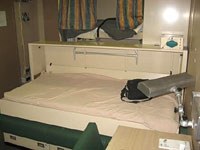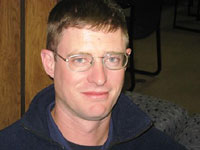

 | |||||||||||||||||
|
|
Journals 2008/2009Steve Howard
August 19, 2008 Today I would like to tell you a little about our home for the next three weeks, the Healy. This is an amazing ship, and I'm just beginning to get a sense of where things are and how to get around. I have been told that there are a number of "behind the scenes" tours we can take, and I'll be telling you more about these as they happen. But for now, here are the basics. The Healy is a huge ship, over 400 feet long, the largest icebreaker operated by the U.S. Coast Guard. Up top, there is the "bridge" which is full of instrument panels and has widows all around to see the seascape. Above the bridge is the "Aloft com," where someone is steering the ship when we are in ice. Below the bridge are the "staterooms," one area for the officers, one for the science team, and one for the rest of the crew. The staterooms are very comfortable, with bunk beds and desks. We share a "head" (bathroom) with an adjoining stateroom, which has a toilet and shower. Below the staterooms you will find the "mess," where we eat, and the "galley" where the cooks work. The food is really very good; every meal has had fresh fruits and vegetables, there is always a salad bar, and desert. If you need a snack, you can head down at any time of day or night and get a quick bowl of cereal or some fruit. You eat cafeteria style, taking what you want and avoiding what you don't. Below the mess deck there is a laundry area and gym with weights and cardio equipment (to work off all this food!). The bow is a great place to watch the ship crash through the ice, and at the stern is the helo-deck (where the helicopter lands) and below that is the "fantail" where a number of cranes are able to deploy or offload equipment. The ship is specially equipped for scientific research, with many complex sonar and echo-sounding equipment, data processing stations, and lab areas for looking at sediment samples, living specimens, and anything else brought up from the sea. I can't begin to describe all the complex data gathering systems all around the Healy! To get from deck to deck you have to go up and down these very steep ladders (it would be a bad fall if you slip on one of these!), and most of the doors are bulkheads with big heavy levers that latch them closed. You have to be careful when opening these doors, because they are very heavy and can clobber you or someone outside if you don't have a good grip on them. And of course, all around you is the open sea and floes of ice. Surrounded by such large things, it's hard not to feel tiny in comparison!
PROFILE:
|
||||||||||||||||



